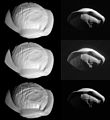Fișier:PIA21436 - Pan, 3 versions.jpg

Mărește rezoluția imaginii (2.040 × 2.220 pixeli, mărime fișier: 965 KB, tip MIME: image/jpeg)
| Acest fișier se află la Wikimedia Commons. Consultați pagina sa descriptivă acolo. |
Descriere fișier
| DescrierePIA21436 - Pan, 3 versions.jpg |
English: Uploader's notes: All three versions of the original NASA image have been modified by increasing pixel dimensions by a factor of 4, sharpening, removing artifacts, cropping and converting from TIFF to JPEG format. In addition, the middle version has been modified by lightening shadows, while the lower version has been modified by decreasing brightness, increasing contrast, lightening shadows, darkening highlights and increasing midtone contrast.
Original caption released with image: These two images from NASA's Cassini spacecraft show how the spacecraft's perspective changed as it passed within 15,300 miles (24,600 kilometers) of Saturn's moon Pan on March 7, 2017. This was Cassini's closest-ever encounter with Pan, improving the level of detail seen on the little moon by a factor of eight over previous observations. The views show the northern and southern hemispheres of Pan, at left and right, respectively. Both views look toward Pan's trailing side, which is the side opposite the moon's direction of motion as it orbits Saturn. Cassini imaging scientists think that Pan formed within Saturn's rings, with ring material accreting onto it and forming the rounded shape of its central mass, when the outer part of the ring system was quite young and the ring system was vertically thicker. Thus, Pan probably has a core of icy material that is denser than the softer mantle around it. The distinctive, thin ridge around Pan's equator is thought to have come after the moon formed and had cleared the gap in the rings in which it resides today. At that point the ring was as thin as it is today, yet there was still ring material accreting onto Pan. However, at the tail end of the process, that material was raining down on the moon solely in (or close to) its equatorial region. Thus, the infalling material formed a tall, narrow ridge of material. On a larger, more massive body, this ridge would not be so tall (relative to the body) because gravity would cause it to flatten out. But Pan's gravity is so feeble that the ring material simply settles onto Pan and builds up. Other dynamical forces keep the ridge from growing indefinitely. These views are also presented in stereo (3-D) in PIA21435. The images are presented here at their original size. The views were acquired by the Cassini narrow-angle camera at distances of 15,275 miles or 24,583 kilometers (left view) and 23,199 miles or 37,335 kilometers (right view). Image scale is 482 feet or 147 meters per pixel (left view) and about 735 feet or 224 meters per pixel (right view). See PIA09868 and PIA11529 for more distant context views of Pan. The Cassini mission is a cooperative project of NASA, ESA (the European Space Agency) and the Italian Space Agency. The Jet Propulsion Laboratory, a division of the California Institute of Technology in Pasadena, manages the mission for NASA's Science Mission Directorate, Washington. The Cassini orbiter and its two onboard cameras were designed, developed and assembled at JPL. The imaging operations center is based at the Space Science Institute in Boulder, Colorado. For more information about the Cassini-Huygens mission visit http://saturn.jpl.nasa.gov and http://www.nasa.gov/cassini. The Cassini imaging team homepage is at http://ciclops.org. |
||
| Dată | |||
| Sursă |
https://photojournal.jpl.nasa.gov/catalog/PIA21436
|
||
| Autor | NASA / Jet Propulsion Laboratory-Caltech / Space Science Institute |
Licențiere
| Public domainPublic domainfalsefalse |
| Acest fişier este în domeniul public fiindcă a fost creat de NASA. Politica drepturilor de autor a NASA spune că „Materialul NASA nu este protejat de dreptul de autor atâta timp cât nu se precizează altfel”. (NASA copyright policy page sau JPL Image Use Policy). |  | |
 |
Atenţie:
|
Captions
Items portrayed in this file
subiectul reprezentat
7 martie 2017
Istoricul fișierului
Apăsați pe Data și ora pentru a vedea versiunea trimisă atunci.
| Data și ora | Miniatură | Dimensiuni | Utilizator | Comentariu | |
|---|---|---|---|---|---|
| actuală | 11 aprilie 2017 06:38 |  | 2.040x2.220 (965 KB) | WolfmanSF | User created page with UploadWizard |
Utilizarea fișierului
Următoarele pagini conțin această imagine:
Utilizarea globală a fișierului
Următoarele alte proiecte wiki folosesc acest fișier:
- Utilizare la en.wikipedia.org
- Utilizare la ja.wikipedia.org
- Utilizare la ko.wikipedia.org
- Utilizare la my.wikipedia.org
- Utilizare la vi.wikipedia.org
Informații
Acest fișier conține informații suplimentare, introduse probabil de aparatul fotografic digital sau scannerul care l-a generat. Dacă fișierul a fost modificat între timp, este posibil ca unele detalii să nu mai fie valabile.
| Lățime | 2.040 px |
|---|---|
| Înălțime | 740 px |
| Metodă de comprimare | Necomprimată |
| Model de culoare | Negru și alb (0 pentru negru) |
| Titlul imaginii |
|
| Orientare | Normală |
| Număr de componente | 1 |
| Rezoluție orizontală | 100 dpi |
| Rezoluție verticală | 100 dpi |
| Software folosit | Adobe Photoshop Elements 12.0 Macintosh |
| Data și ora modificării fișierului | 9 aprilie 2017 11:20 |
| Versiune exif | 2.21 |
| Spațiu de culoare | Necalibrată |
| Data ultimei modificări a metadatelor | 9 aprilie 2017 04:20 |
| Data și ora digitizării | 9 aprilie 2017 04:20 |
| ID-ul unic al documentului original | xmp.did:A2E63BC6E604E7118A44FA541FDA1808 |